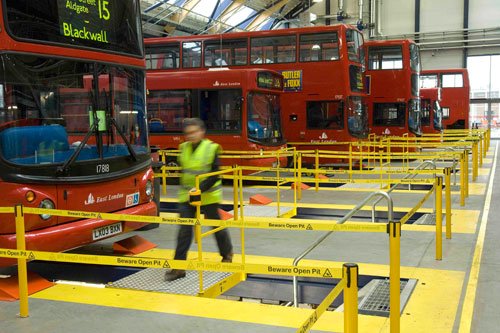The motor vehicle repair industry has always been associated with more everyday risks than most, argues Brett Hellyer, who offers some advice on what businesses can do to minimise risks cost effectively.

Between 2008 and 2012, 8,600 injuries were reported to HSE and local authorities for the motor vehicle repair industry. In the same period, 33 people were killed. In 2013, slips, trips and falls were more common in transport than any other sector.
You might assume that many of these reports were for minor accidents. However, being hit by moving vehicles, fires and falling from height are the most common causes of injury.
Falls occur more often in large, commercial garages and depots, due to the use of inspection pits to work on large vehicles that are unsuitable for ramps. These pits, which typically measure around one and a half metres wide and two metres deep, can be particularly dangerous to work around when uncovered, with sharp edges that can cause broken limbs and a drop onto a concrete floor.
They are the primary cause of ‘fall from height’ cases in the workshop. In 2011/12 alone, this accounted for 79 injuries. HSE now recommends an increasing number of measures to reduce the risk of falls into pits, from automatic motorised covers to bridges.
To protect the premises effectively, I’m a firm believer in the simple solutions. Bus operator Stagecoach, for example, uses high-visibility retractable barriers around all of the pits in its UK depots. Systems such as this are much more cost effective and have the benefit of more flexibility, depending on the sizes and types of vehicles and how the pits are being used at the time.
Investing in prevention methods early on is a far more worthwhile and painless method of handling the risk, rather than simply hoping for the best. With such narrow margins in an increasingly squeezed industry, cost-effective methods are becoming all the more important. Having a safe, confident and happy workforce is even more so.
Installing a permanent solution can be well worth the investment, as many garages may use simple temporary cones or a rope across pit openings, which, inevitably, get forgotten about.
If every commercial vehicle repair business — or repair divisions of larger transport businesses — invested in a permanent but a cost-effective solution to make such a troublesome hazard safer, then the industry as a whole could benefit from safer working environments, reduced legal risks and less negative publicity.
Brett Hellyer is a specialist in the health and safety sector at Tensator
This eBook will guide you through some of the key understandings you need to be able to manage driver safety effectively and, at the end, provide a series of free resources you can access to help you ensure your own driver safety management system is robust, legally compliant and in line with industry-accepted good practice.
Download this eBook from Driving for Better Business and SHP to cover:
- Why do we need to manage driver safety?
- Duty of care – a shared responsibility;
- Setting the rules with a driving for work policy;
- Managing driver safety;
- Ensuring safe vehicles;
- Safe journeys and fitness to drive;
- Record keeping;
- Reporting;
- The business benefits of good practice;
- Additional resources


